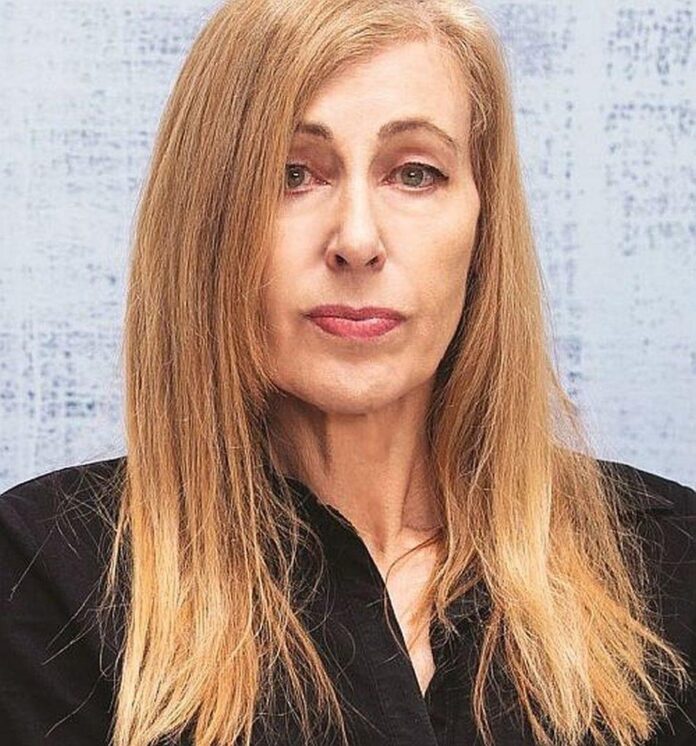The American-born, London-based artist Julie Umerle is a contemporary abstract painter whose work has been exhibited widely both in the United Kingdom and abroad. She has been the artist-in-residence at the Marriott Hotel in Canary Wharf, London, since 2017, and in 2019 was named one of ’s “100 Contemporary Artists”—the same year her memoir, , was published.
Comprised of ongoing series that explore the process and possibilities of abstraction, Umerle’s oeuvre can be seen as a formidable synthesis of the rich traditions of color field painting and geometric abstraction. Her subtle and meticulous canvases in many ways operate as investigations into the myriad of ways color, shape, and scale interact, both within a single composition as well as across series.
An extension of Umerle’s practice is her support of charities and charitable trusts through her art. Over the years, she has aided such causes as cancer research and dementia care, among others.
We recently spoke with Umerle to learn more about her practice and what she’s working on next.

Julie Umerle, (2022). Courtesy of the artist.
Tell us about your background. How did you come to be an artist? What was your early career like?
I studied painting at Falmouth University in Cornwall. On graduating I returned to London, moving from studio to studio and exhibiting at every opportunity. It was a challenging time, but very rewarding. In 1996, I traveled to New York City to further my art education, pursuing an MFA at Parsons School of Design. This led to many new developments in my work. After gaining my master’s degree, I lived and worked between London and New York City for several years.
Your work is largely made in ongoing series. Can you give us a bit of insight into your creative process? Where do you start?
Ideas often develop from previous work in a continual loop, moving backwards and forwards in time. I will often start with rough sketches and refine those on canvas once the painting is in progress. I spend a lot of time looking at my paintings. Things change as the painting proceeds—colors, shapes, edges. I always find it important to keep in touch with a painting once it is started. Then it begins to take on its own presence.
The art world has changed a lot over the past two years, and a lot of artists’ perspectives have changed as a result of the pandemic. Has your approach evolved?
During the pandemic, I began to work very freely on canvas with a change of palette and expressionistic handling of paint. I also started to explore scale. This new set of images was displayed digitally on screens in London’s Oxford Street. Recently my paintings have become more rigorous and defined, using geometric shapes and color. Another development as a result of the pandemic has been an increased use of online platforms to exhibit and sell art rather than a reliance on traditional exhibitions. This is particularly useful for an independent artist, allowing for more control for those who create the work.

Julie Umerle, (2020). Courtesy of the artist.
Which artists or movements, historical or contemporary, have influenced your work the most?
Early influences were American artists Robert Ryman, Agnes Martin, Mark Rothko, Helen Frankenthaler—too many to mention here. Of course, I have also been interested in following the work of my peers, particularly abstract painters, of which there are a huge number.
Can you talk about the work and forthcoming exhibition in Cologne?
I am participating in an exhibition and charity auction which will be held next year at Sotheby’s Palais Oppenheim in Cologne from September 29–October 5. It has been curated by Michael Schmidt-Ott and is the fifth such auction he has curated (and the first in Germany). All proceeds support people with dementia and their families. This project includes 200 artists from 54 different countries, which makes it the most international charity art auction ever. Sotheby’s will be auctioning the works on October 5, 2023 with an accompanying published catalogue. My painting has already been selected and is currently safely in storage in Germany.
What are you working on in the studio? Are there any themes or subjects you want to engage with that you haven’t yet?
I am continuing my series of geometric paintings, positioning shapes on rectangular canvases rather than squares. This changes the dynamics and the space of the paintings. I am also using a wide range of colors rather than a restricted palette. Through small shifts of approach like these, I am able to continue developing my practice and exploring abstract ideas. There are many themes and subjects I would like to engage with, but it is impossible to achieve everything an artist wants to—the possibilities are infinite.
If you weren’t an artist, what do you think you would be?
I love what I do. I couldn’t imagine being anything other than an artist.

Julie Umerle, (2022). Courtesy of the artist.

























